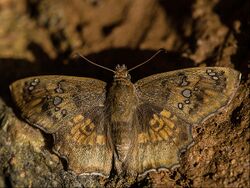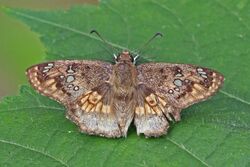Biology:Abaratha ransonnetii
From HandWiki
Short description: Species of butterfly
| Golden angle | |
|---|---|

| |
| Wet-season form | |
| Scientific classification | |
| Domain: | Eukaryota |
| Kingdom: | Animalia |
| Phylum: | Arthropoda |
| Class: | Insecta |
| Order: | Lepidoptera |
| Family: | Hesperiidae |
| Genus: | Abaratha |
| Species: | A. ransonnetii
|
| Binomial name | |
| Abaratha ransonnetii (C. Felder, 1868)
| |
| Synonyms | |
| |
Abaratha ransonnetii, commonly known as the golden angle,[1] is a butterfly belonging to the family Hesperiidae. It was first described by Baron Cajetan von Felder in 1868.[2][3][4][1][5][6]
Subspecies
The following subspecies are reconised:
- Abaratha ransonnetii potiphera Hewitson, 1873 (India)[1][7][8]
- Abaratha ransonnetii ransonnetii (Sri Lanka)[8]
Range
It occurs in India (Gujarat, Jharkhand, Odisha and southwards to Kerala) and Sri Lanka.[8][1][7]
Description
In 1891, Edward Yerbury Watson gave this detailed description:
Upperside fuliginous ochreous-brown. Male; forewing with three small semi-transparent white spots before the apex (and sometimes one or two very minute spots obliquely below them), two spots within end of the cell, a slender spot between the upper and middle median veins, a larger spot between the latter vein and submedian, and followed below it by two small obliquely disposed spots; a marginal double row of pale indistinct small lunules; hindwing with a broad medial discal macular pale ochreous band traversed by brown veins and a spot within end of the cell, the outer discal area suffused with grey-brown. Cilia alternated with white. Female; forewing with the spots and marginal lunules, and the macular band on hindwing more prominent, the latter also more distinctly bordered with grey. Underside: forewing paler brown; the basal area greyish-white, the spots with clouded black outer borders; hindwing greyish-white, the outer margin only being brown, traversed by a curved discal series of small blackish spots.[8] The dry-season form which has been named A. taylorii by de Niceville differs in being ochreous not dark brown above, and in having the disc of the hindwing unmarked with a group of ochreous spots and streaks. A similar variation has been noted by Mr. de Niceville in C. tissa, a not very distantly allied species, and in both cases it is the dry-season form which is the paler.[8]—E.Y. Watson
Gallery
References
| Wikimedia Commons has media related to Abaratha ransonnetii. |
- ↑ 1.0 1.1 1.2 1.3 Varshney, R.; Smetacek, P.. A Synoptic Catalogue of the Butterflies of India (2015 ed.). New Delhi: Butterfly Research Centre, Bhimtal and Indinov Publishing. p. 33.
- ↑ Savela, Markku. "Caprona ransonnetii (Felder, 1868)". http://www.nic.funet.fi/pub/sci/bio/life/insecta/lepidoptera/ditrysia/hesperioidea/hesperiidae/pyrginae/caprona/#ransonnetii.
- ↑ Felder, Baron Cajetan von (1868). "Diagnose neuer von E. Baron v. Ransonnet in Vorder-Indien gesammelter Lepidopteren". Zoologisch-Botanische Gesellschaft in Wien 18 (1–2): 284. https://archive.org/stream/verhandlungender1868zool#page/284/mode/1up.
- ↑ Moore, Frederic (1880). The Lepidoptera of Ceylon. London: L. Reeve & co.. pp. 182. https://archive.org/stream/lepidopteraofcey01moor#page/182/mode/1up.
- ↑ W. H., Evans (1949). A Catalogue of the Hesperiidae from Europe, Asia, and Australia in the British Museum. London: British Museum (Natural History). Department of Entomology. pp. 160. https://www.biodiversitylibrary.org/item/187283#page/184/mode/1up.
- ↑
 This article incorporates text from a publication now in the public domain: Swinhoe, Charles (1912–1913). Lepidoptera Indica. Vol. X. London: Lovell Reeve and Co.. pp. 73–75. https://www.biodiversitylibrary.org/item/103495#page/87/mode/1up.
This article incorporates text from a publication now in the public domain: Swinhoe, Charles (1912–1913). Lepidoptera Indica. Vol. X. London: Lovell Reeve and Co.. pp. 73–75. https://www.biodiversitylibrary.org/item/103495#page/87/mode/1up.
- ↑ 7.0 7.1 "Caprona ransonnettii Felder, 1868 – Golden Angle". http://www.ifoundbutterflies.org/#!/sp/667/Caprona-ransonnettii.
- ↑ 8.0 8.1 8.2 8.3 8.4 E. Y., Watson (1891). Hesperiidae Indicae : being a reprint of descriptions of the Hesperiidae of India, Burma, and Ceylon. Madras: Vest and Company. pp. 99. https://www.biodiversitylibrary.org/item/64080#page/113/mode/1up.
Wikidata ☰ Q3595417 entry
 |




